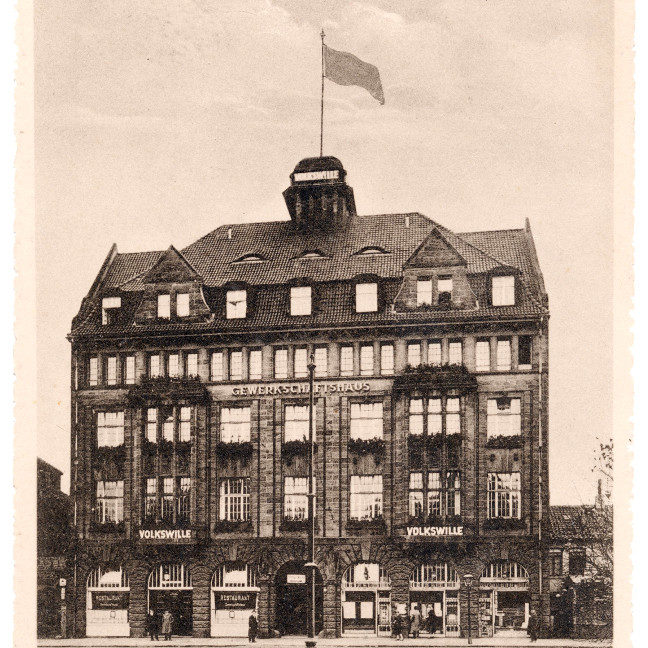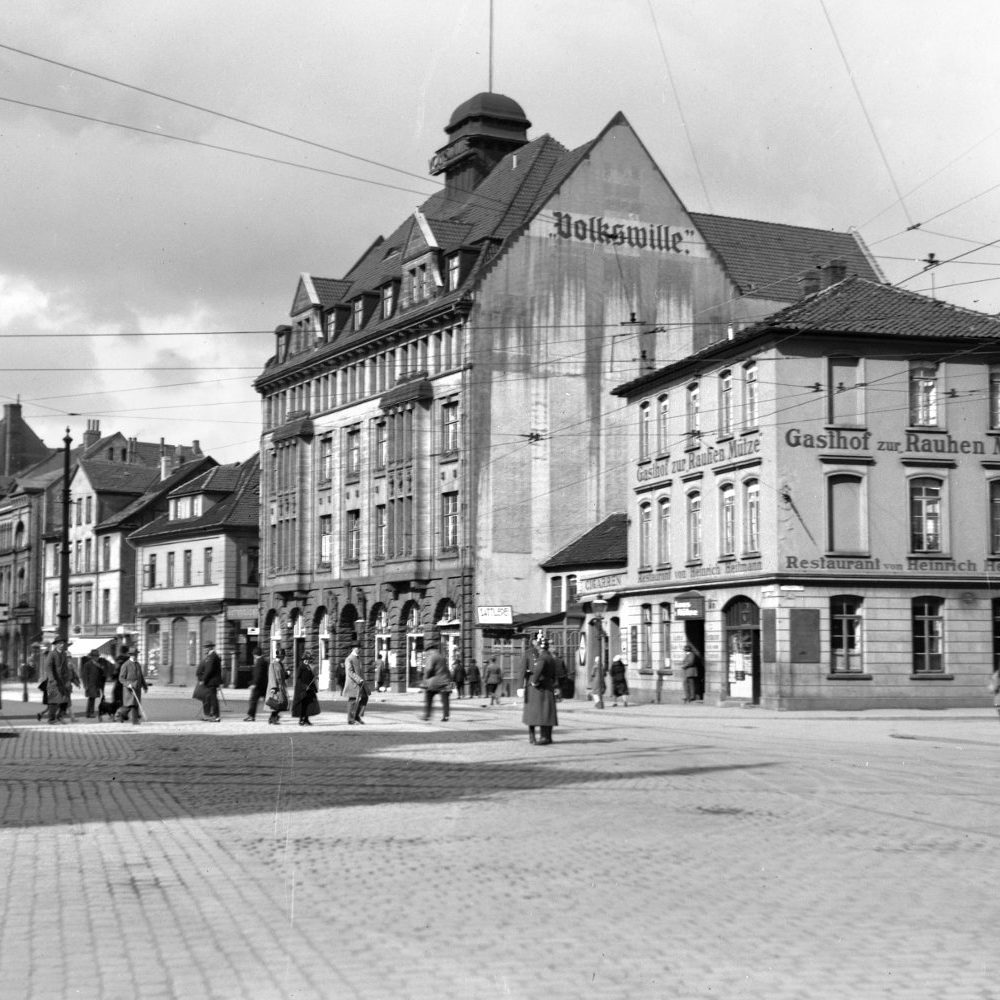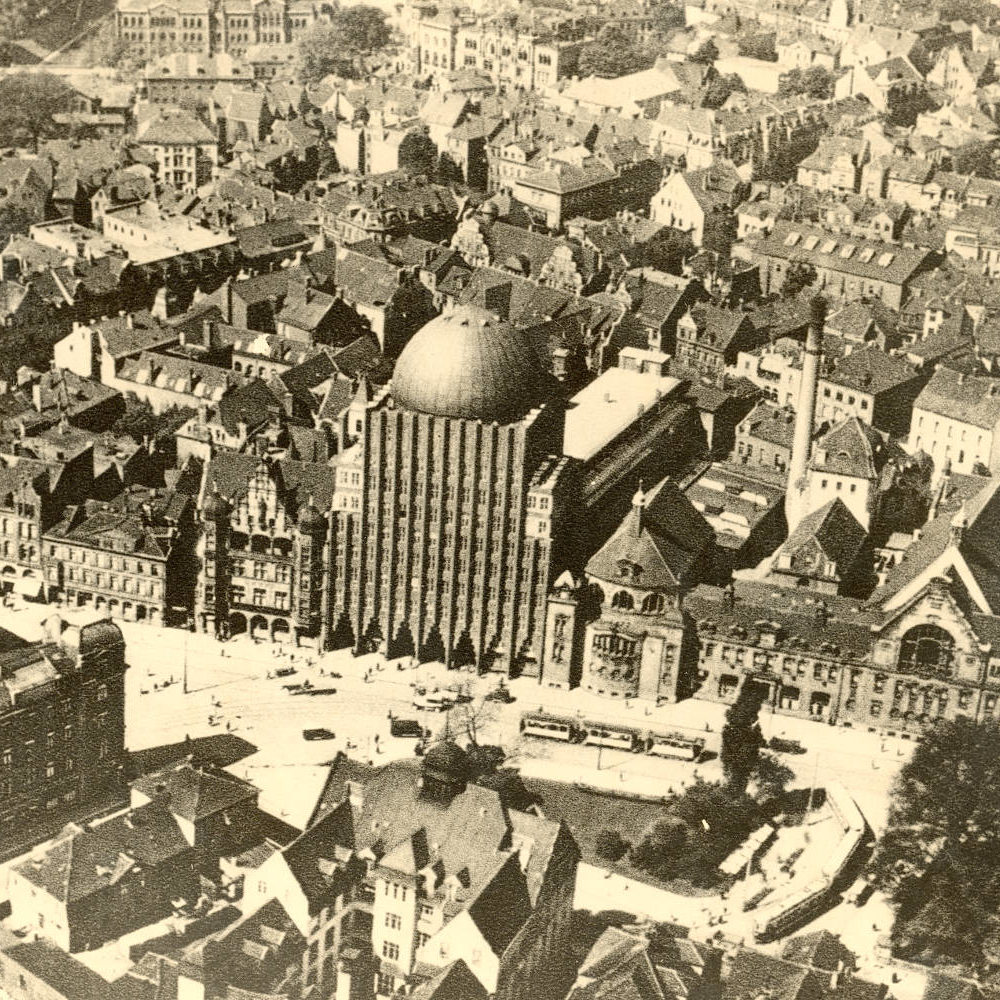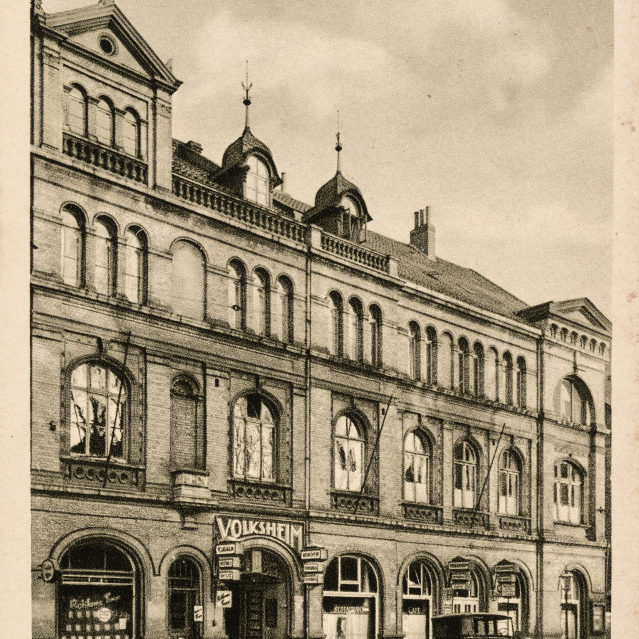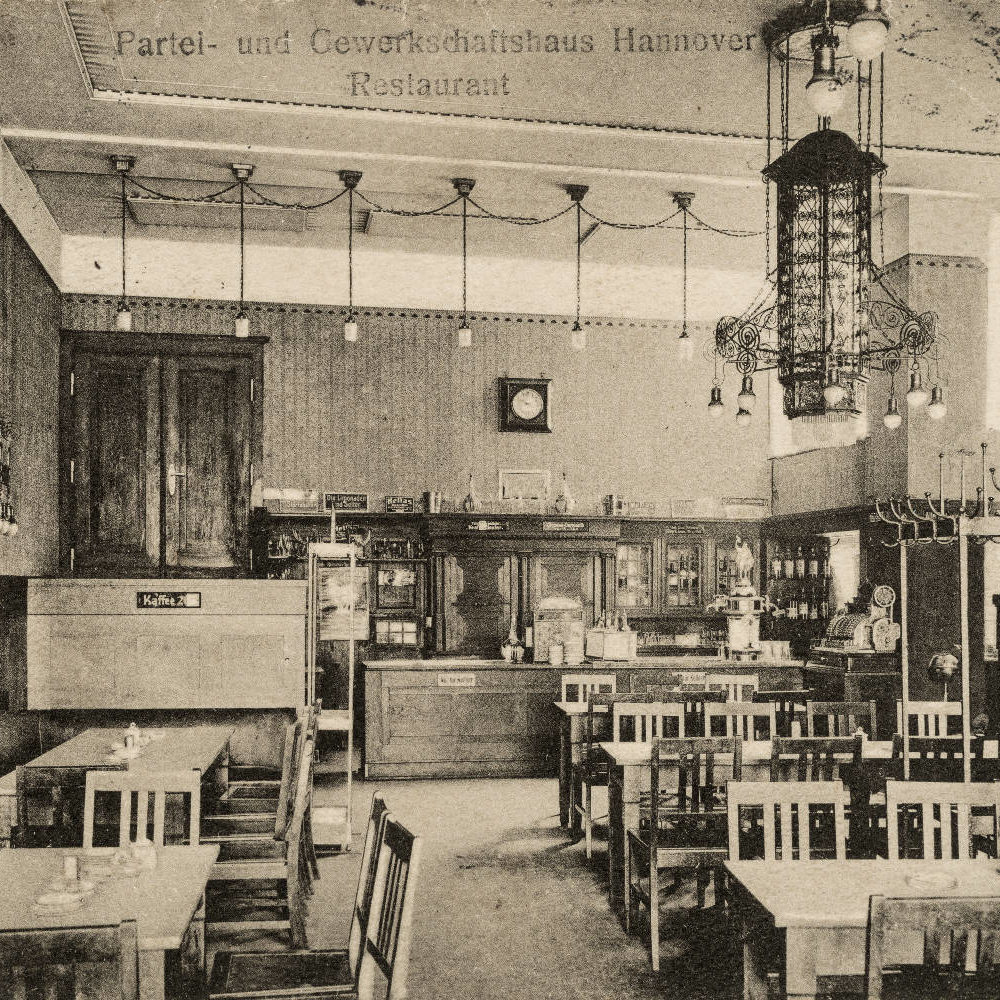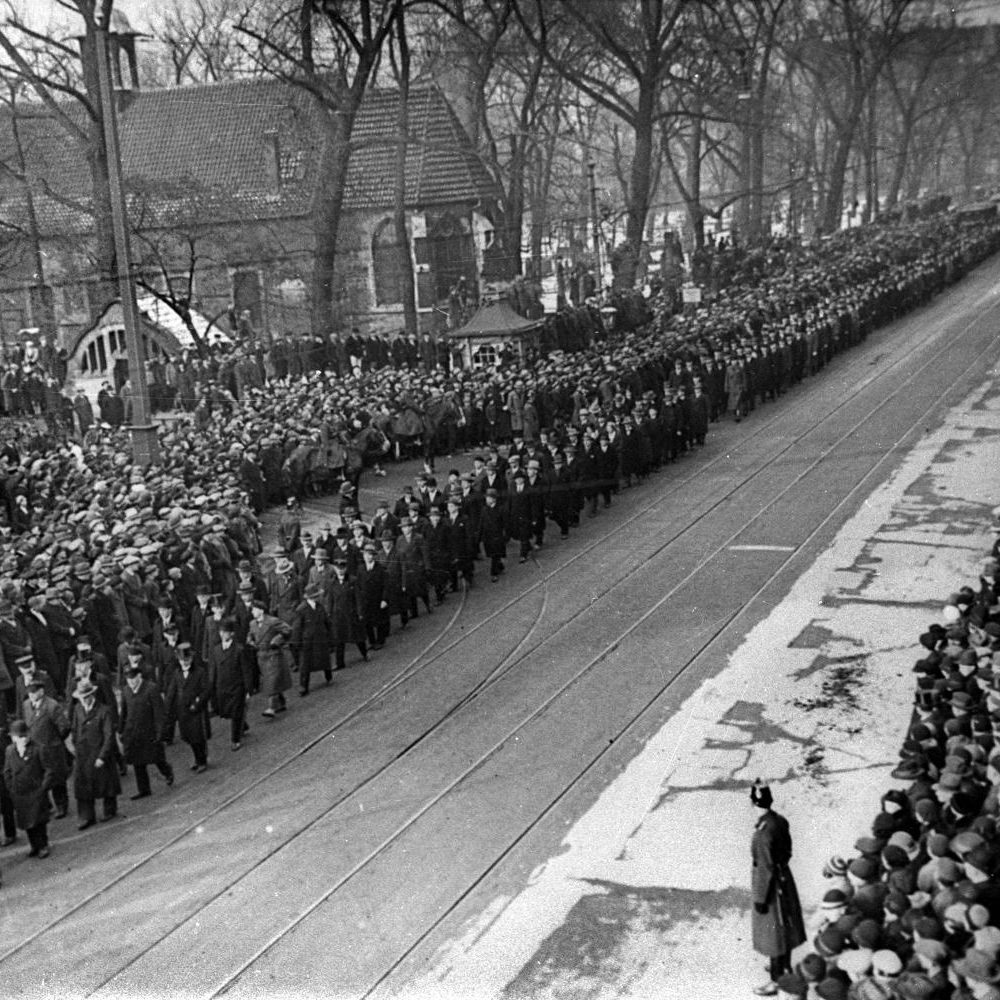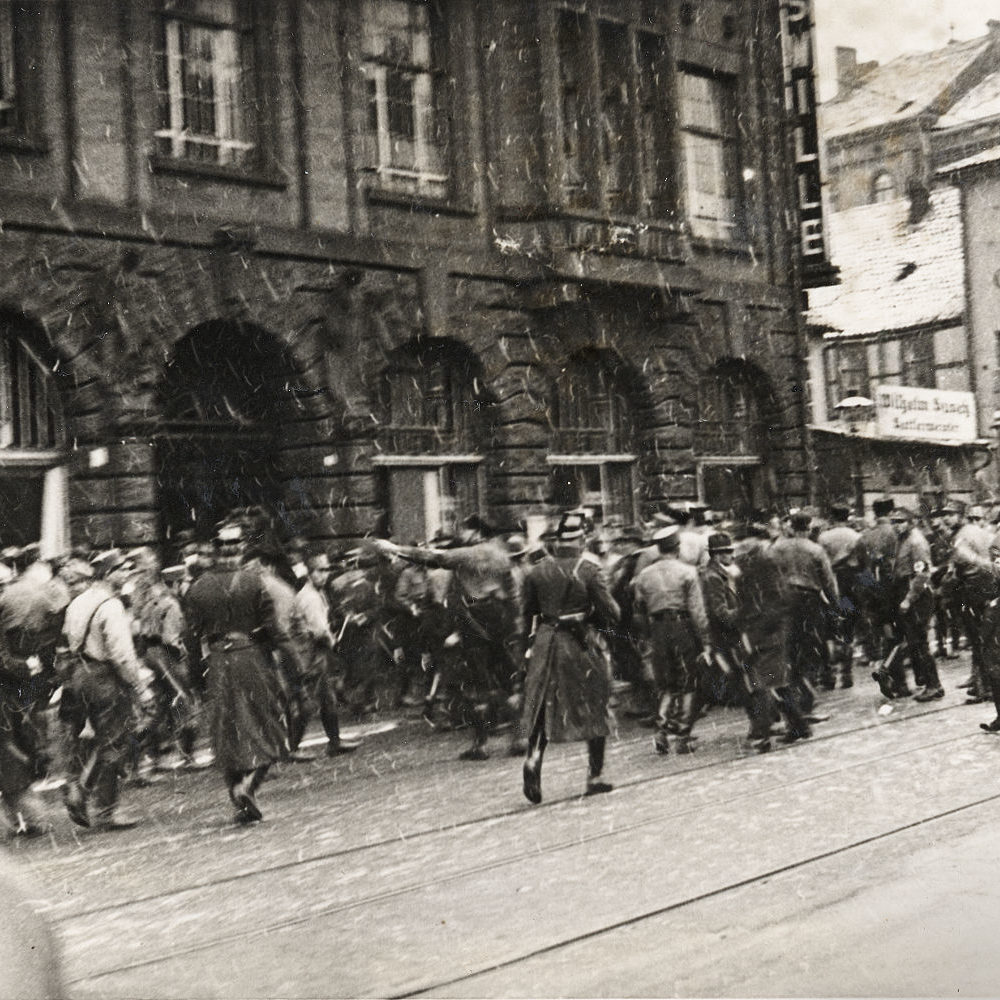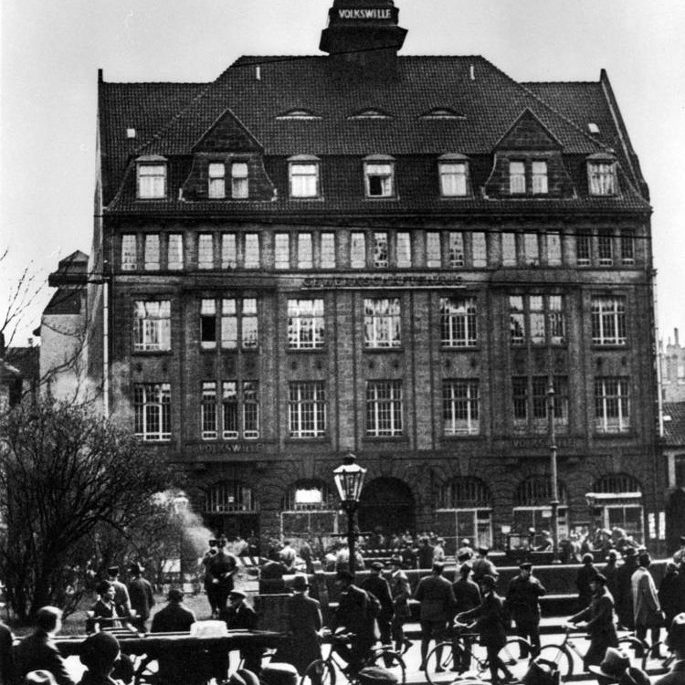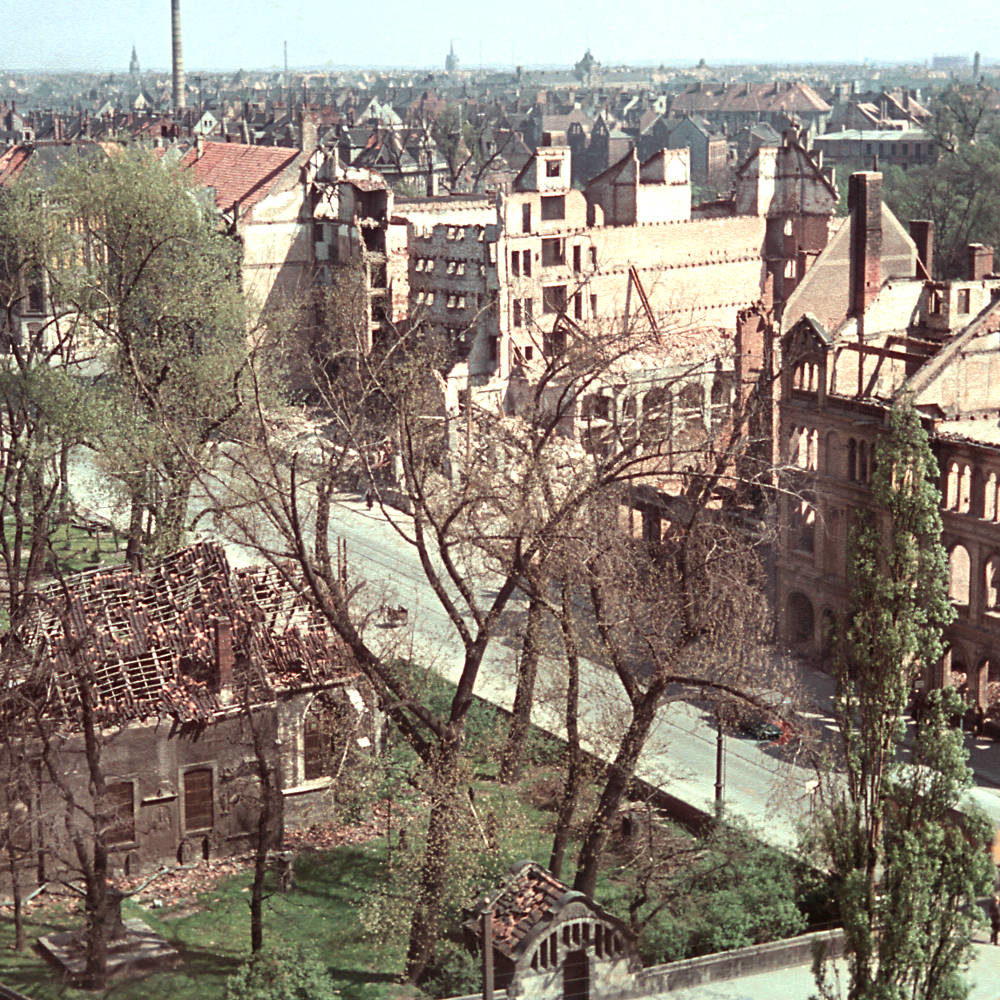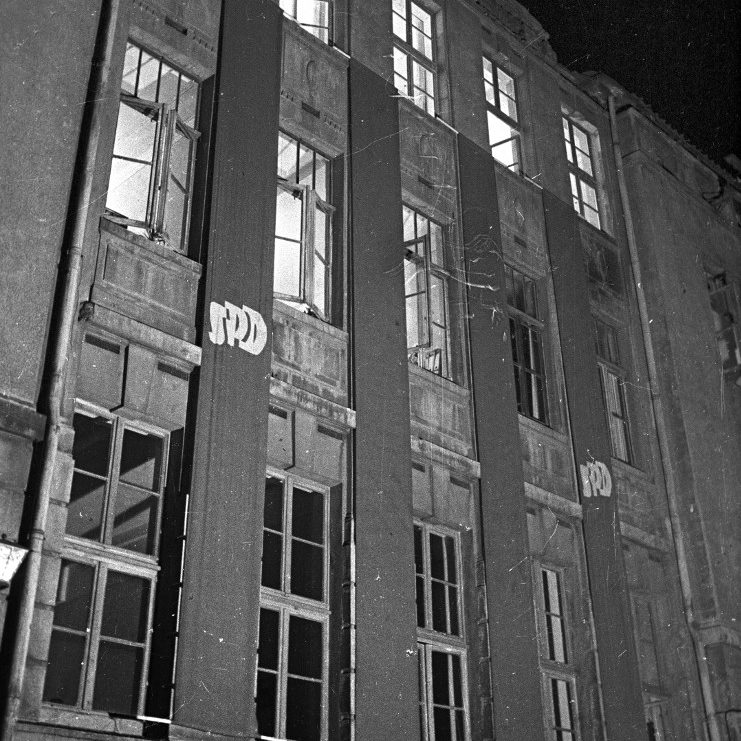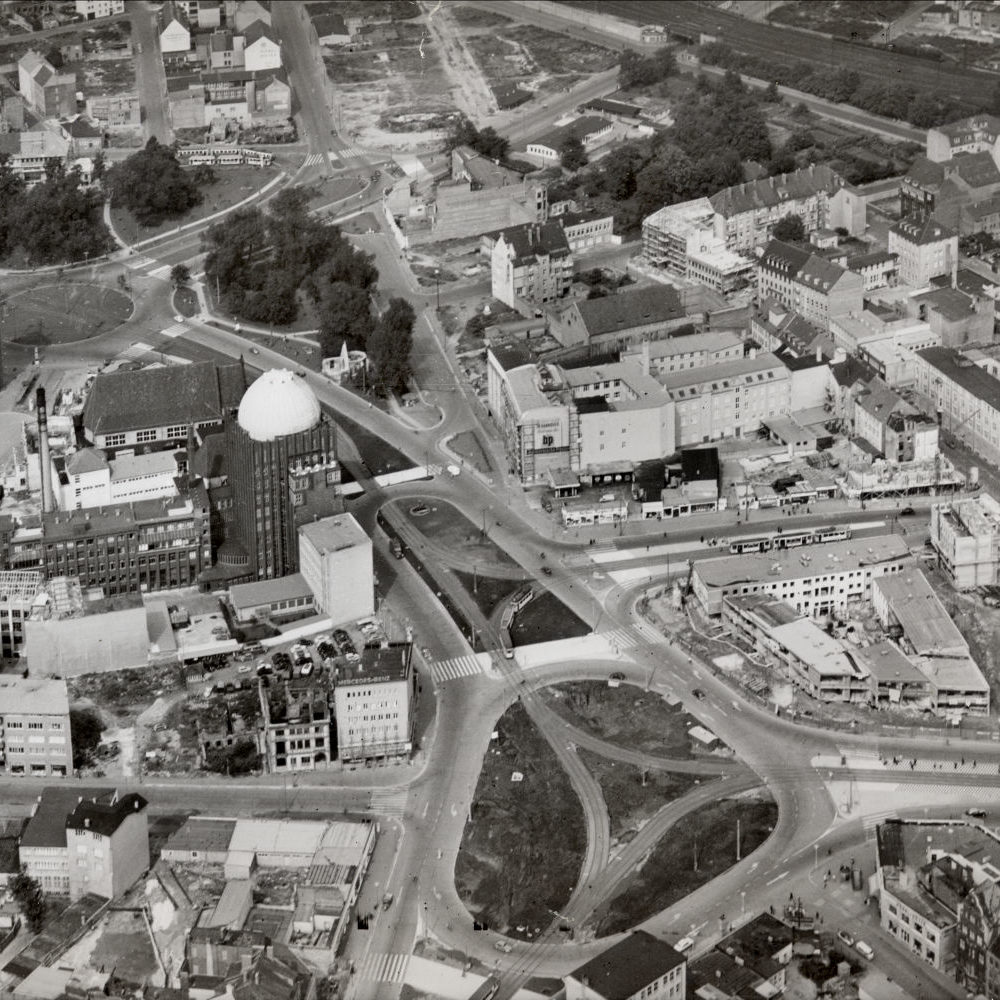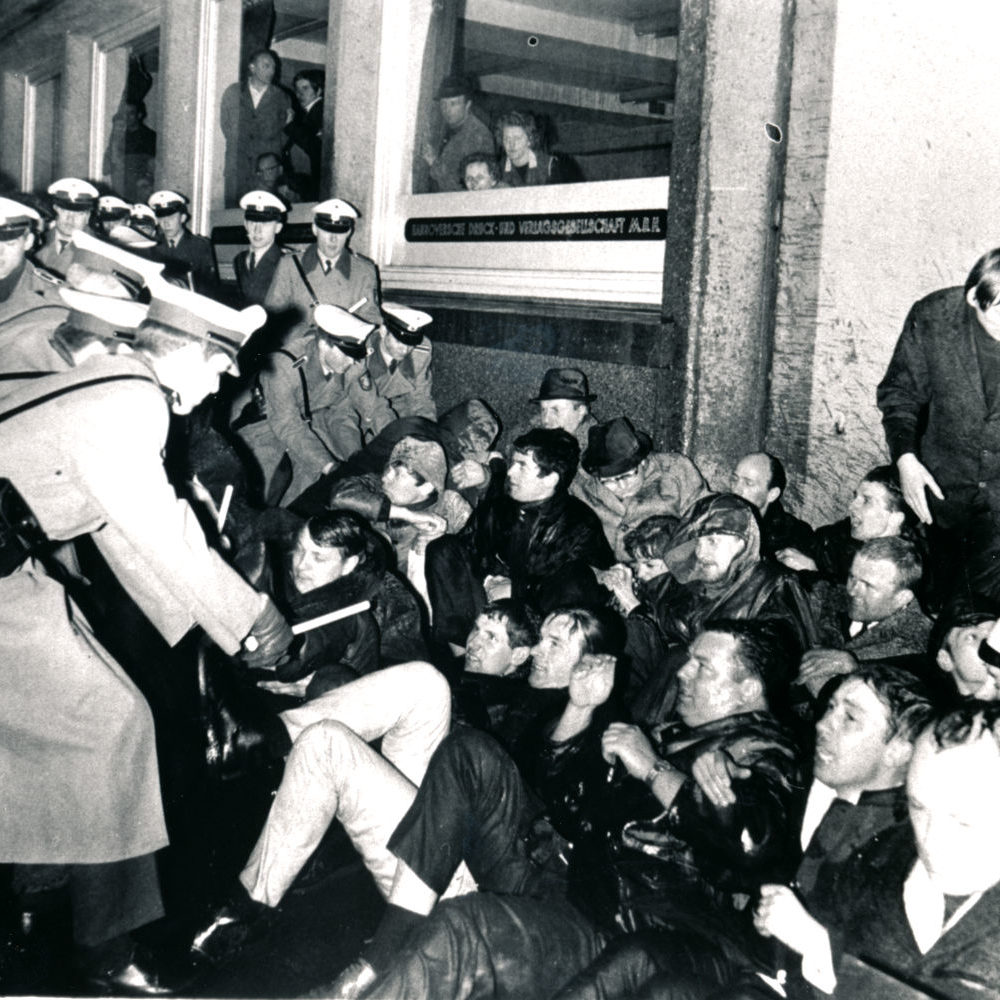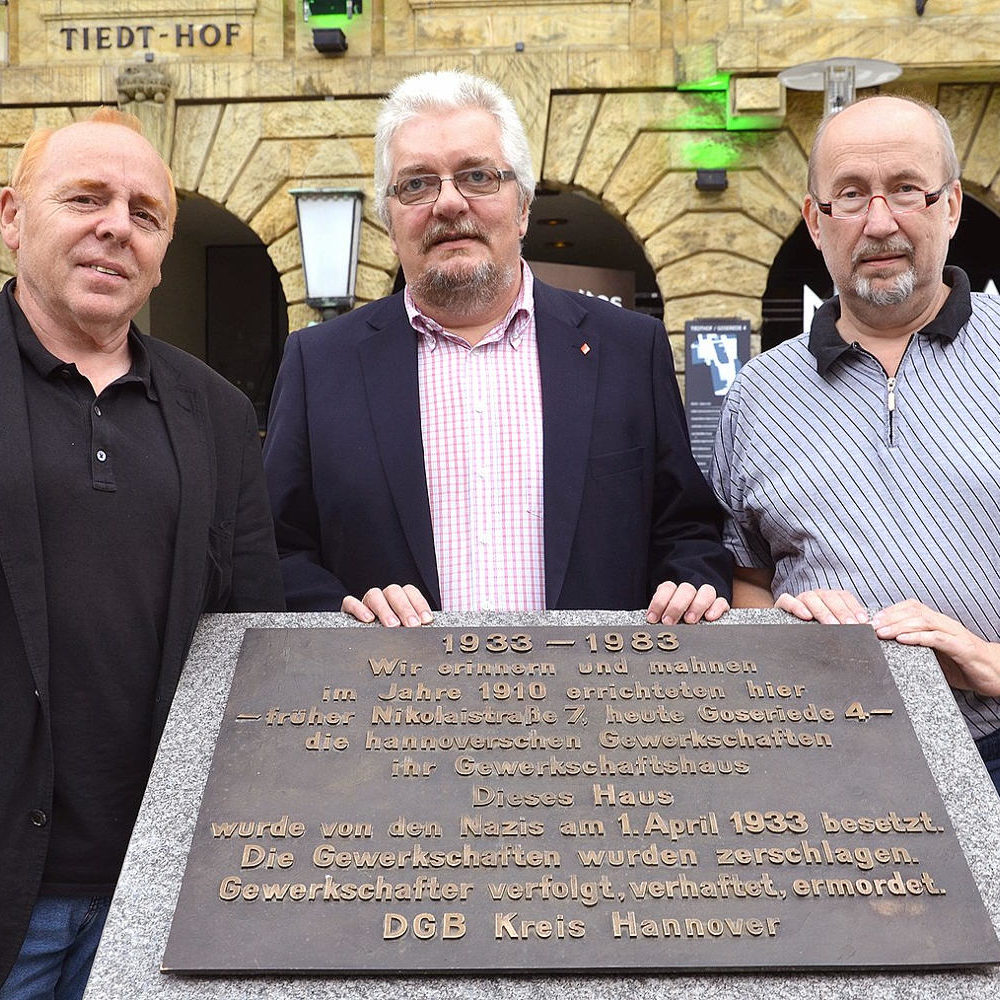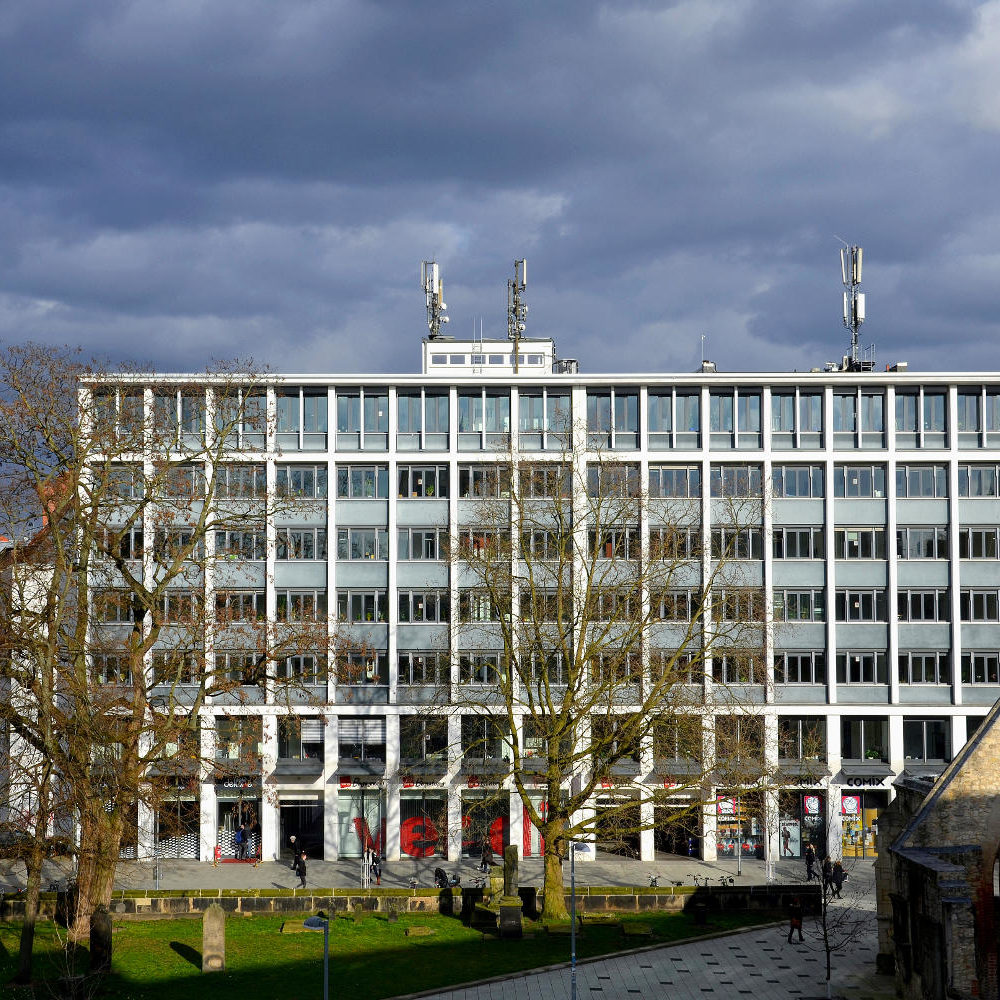The heart of Hanover’s labour movement: Hanover’s trade union building was a large housing complex situated between Goseriede and Odeonstrasse with several inner courtyards. It served as the headquarters of the SPD newspaper “Volksstimme” [literally, ‘Voice of the People’] and many individual trade unions. As early as 1 April 1933, it was raided and occupied by armed National Socialists.
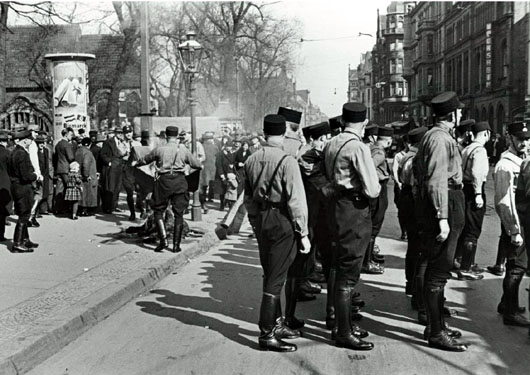
One of many trade union houses in Germany
The idea of trade union houses is born out of necessity. While the German labour movement grows vigorously before the First World War, spaces for members to meet and its organisations are often denied. Hence the need to create their own trade union halls and “Volksheime” [social, cultural and educational centres, established by the Social Democratic Party]. By 1922, they had been founded in over one hundred German cities.
Yet in Hanover, finding a centrally located building plot is not easy. Acquisition of the city-owned urban plot of land on Goseriede, later the site of the “Anzeiger-Hochhaus” building [home to the publishers of the “Hannoverscher Anzeiger” newspaper], fails due to opposition from Heinrich Tramm, the national conservative Stadtdirektor [chief administration officer]. So, in 1909, the unions buy a large plot of land across the road using two breweries as a front. It is situated between Nikolaistrasse (now Goseriede), Odeonstrasse and Artilleriestrasse (now Kurt-Schumacher-Strasse).
Inauguration 1910
As early as October 1910, it is possible to inaugurate the main building at Nikolaistrasse 7, followed soon after by the middle building and the hostel building on Odeonstrasse. The contractors are the Free Trade Unions of Hanover and the local branch of the SPD.
Directly after the First World War, a large building complex is built alongside it: the hall and restaurant building belonging to the “Kriegerheim” [home for war veterans] at Nikolaistrasse 10 is converted into the “Volksheim” for the labour movement with a hall that can accommodate up to 2,000 people.
The archetypal image of the enemy in the Nazi mind
The buildings provide space for the headquarters of several individual trade unions and the “Allgemeiner Deutscher Gewerkschaftsbund” [General Federation of German Trade Unions], abbreviated to ADGB, for trade union organisations such as the Arbeiterwohlfahrt [Workers’ Welfare] and Volksfürsorge [an insurance company created as a trade union cooperative joint-stock company], the editorial and printing offices of the Social Democratic newspaper “Volkswille” [“Will of the People” ], meeting rooms and libraries, a community book shop, and “Frischauf”, a bicycle company for the working classes, a restaurant and beer hall, a hotel and a simple hostel for travelling workers, and also a few apartments.
The union building symbolises the power of the labour movement and is thus a thorn in the side of the National Socialists. Hanover’s ‘brown’ [Nazi] press call it “red murder headquarters” and “the headquarters of the organised criminal rabble”. As early as 1932, the SA [SA is the abbreviation of ‘Sturmabteilung’, literally ‘Storm Detachment’, the Nazis’ paramilitary wing, known as ‘Brownshirts’] carries out numerous attacks on the building. The first organised raid on the trade union centre takes place on 16 June 1932. Men of SA-Sturm 100 make their way from their regular local tavern “Kreuzklappe” in the old part of Hanover over to Goseriede and try in vain to enter the restaurant.
The final occupation
On 1 April 1933, the trade union building is occupied by armed SA and SS troops. On the pretext that shots have allegedly been fired from the trade union premises, they storm the building complex, search every room, throw property out of the windows, set fire to trade union banners on the pavement and hoist the swastika flag in triumph. The events are secretly photographed by Walter Ballhause, a workers’ photographer and social documenter.
Shortly afterwards, the Nazis’ pseudo-union, the “Deutsche Arbeitsfront (DAF)” [German Labour Front], moves into the trade union building. In address books for Hanover issued after 1933, it is called “Haus der deutschen Arbeit”, “House of German Labour”.
Legal course taken by the SPD
At the time the building is stormed, Hitler has been Reich Chancellor for two months, the police force is in the hands of the National Socialists and, after the burning down of the Reichstag [the German parliament building] on 27 February 1933, many fundamental rights enshrined in the Weimar constitution have been suspended.
The 60 or so men of the Social Democratic “Reichsbanner Schwarz-Rot-Gold” [‘Black, Red, and Gold Banner of the Reich’, an organisation formed during the Weimar Republic to defend parliamentary democracy] guarding the buildings put up no resistance. For months their party had called for “calm and level-headedness” and ruled out any armed resistance. Thus, the Social Democratic workers’ movement in Hanover too becomes a victim of the strictly legal course that it took – whereas the new rulers only technically abide by the laws, but in reality, systematically violate them.
Post-1945
So, what became of the trade union house and the “Volksheim” after the war? The “Volksheim” is destroyed in the war and in the early 1950s, the site on which it stood is purchased by the SPD and redeveloped. Between 1957 and 1974, the “Hannoversche Presse”, a high-circulation daily newspaper for Lower Saxony, is published here in the “Pressehaus”. From 1971 onwards, following a merger, the newspaper is known as the “Neue Hannoversche Presse”. Over Easter 1968, in the wake of the assassination attempt on student leader Rudi Dutschke, the local edition of the “Bild” newspaper, as in other cities, is blocked in Hanover – this is also printed in the Pressehaus. For several hours, the Bild newspaper is prevented from being delivered, whereas the “Hannoversche Presse” is handed out through the windows and – under the scrutiny of the demonstrators – loaded into distribution vehicles. The blockade ends around midnight on 12 April 1968 with a street battle involving the use of water cannons and rubber truncheons. In 1972, the SPD parts company with the loss-making daily newspaper, which is then absorbed into the Verlagsgesellschaft Madsack [Madsack publishing group]. Since 1974, it has been printed in Bemerode [a district of Hanover] and from 1978 as a local newspaper under the name “Neue Presse”. In 1982, the building complex at Goseriede 10 is sold to a private investor. Nowadays, it is home to the “Verdi-Höfe”, the premises of ver.di, the United Services Trade Union.
Following construction of a new building on Klagesmarkt, the main trade union house building is sold in 1953 to the textile magnate Konrad Tiedt. In 1998, the building complex is renovated by a Hamburg entrepreneur and converted into business premises and an events venue known as “Tiedthof”. Only the Hanover SPD remains where it first had its offices in 1924-1933 and then, after 1945, in the building at Odeonstrasse 15-16. Until its relocation to Bonn, the SPD party executive is based here under Kurt Schumacher.
Additional online information
LEMO The crushing of the trade unions [in German]
DGB The crushing of the free trade unions in 1933 [in German]
“Der Spiegel” article from 22 April 1968 covering the Springer blockades in Hanover and elsewhere: Springer publishing houses: Weint euch aus [Cry your hearts out] [in German]
DGB Region Lower Saxony-Central Region Topics Politics & Society [in German]
Further reading: Click here
Texts and images: Michael Pechel

